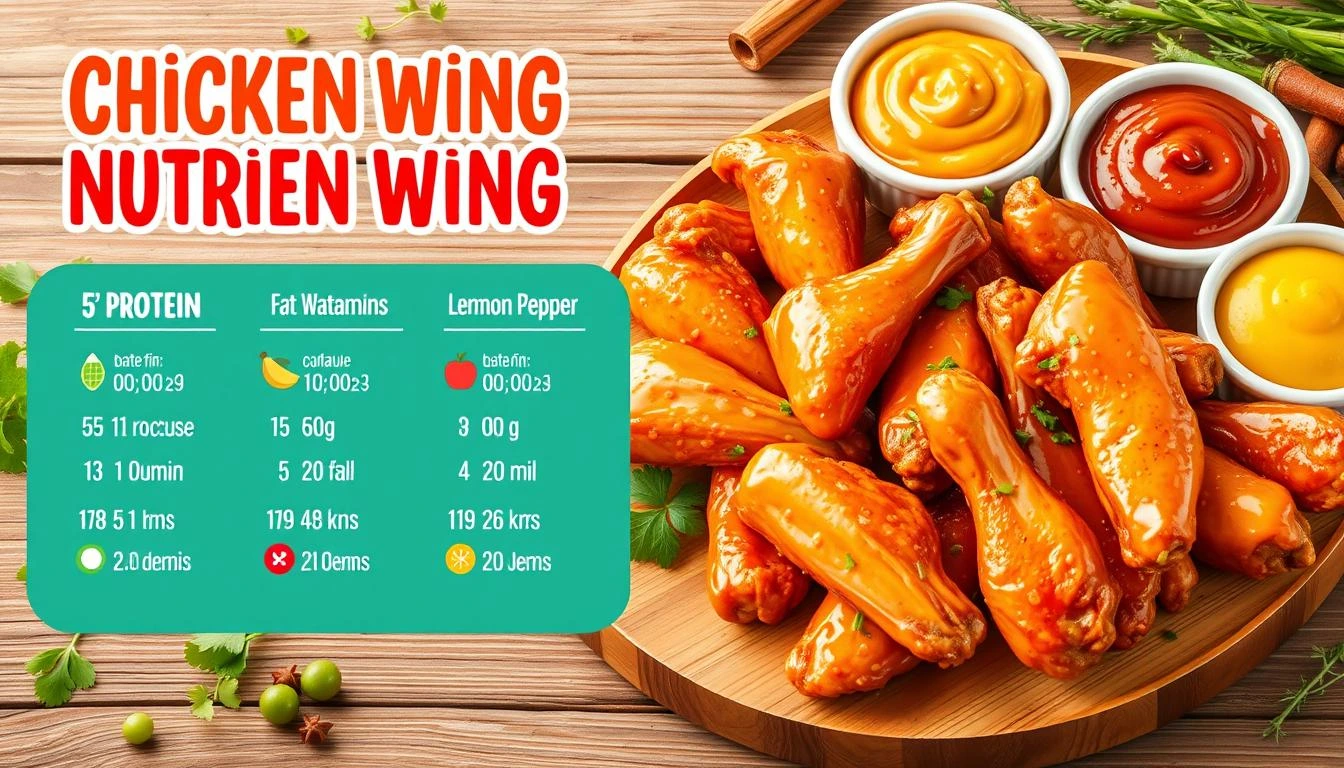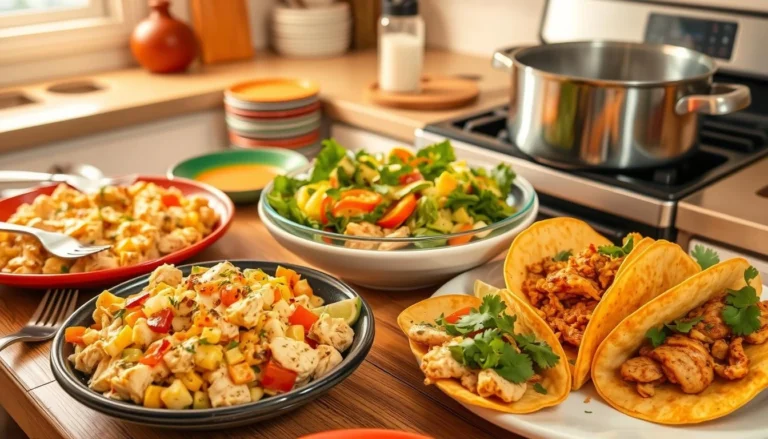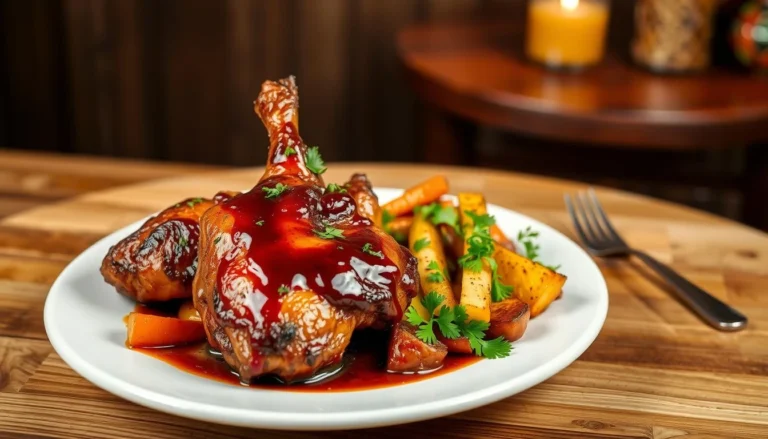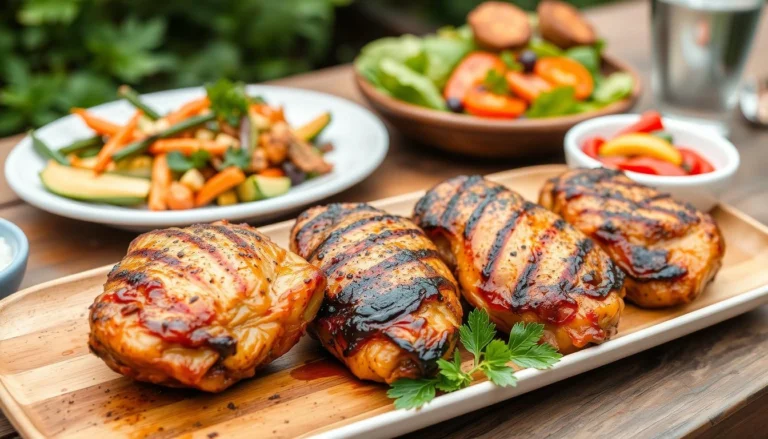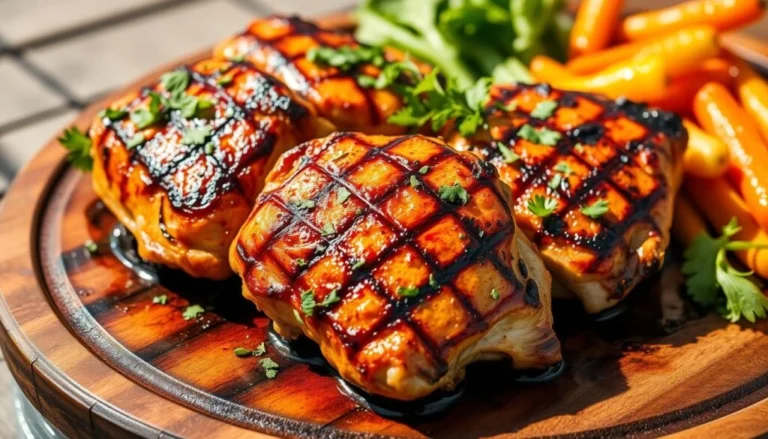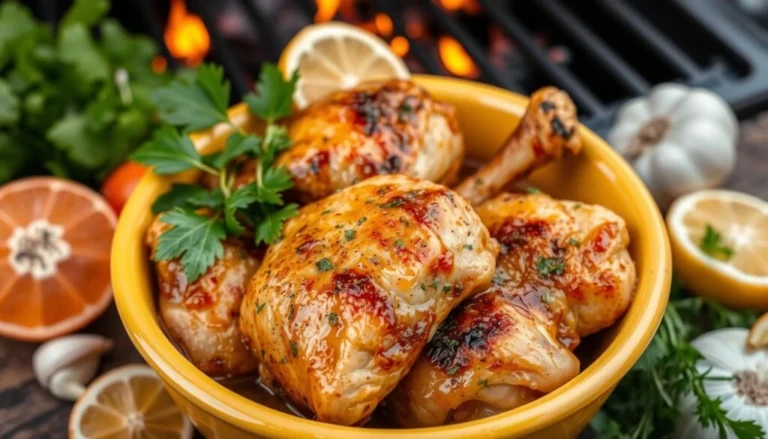Chicken Wings Nutrition: A Closer Look at the Benefits
Table of Contents
Imagine game day with friends, and a platter of golden, crispy chicken wings is the star. Chicken wings are not just tasty; they also pack a surprising health punch. Whether you’re into fitness or just love snacks, knowing the nutritional value of chicken wings can change how you see them.
Chicken wings are more than a tasty snack. They have about 6 grams of protein per wing, which helps build and keep muscles strong. With a moderate calorie count, they’re a good choice for those watching their diet but still want a filling meal.
Key Takeaways
- Chicken wings provide substantial protein for muscle health
- Low in carbohydrates, suitable for various diet plans
- Contains essential vitamins and minerals supporting overall wellness
- Collagen in chicken wing skin supports joint health
- Preparation method significantly impacts nutritional value
Introduction to Chicken Wings Nutrition
Chicken wings are more than just a tasty snack for game days. They are packed with nutrients that can help balance your diet if made with care. Knowing the health benefits of chicken wings can guide you to better food choices.
Let’s dive into the nutritional details of chicken wings:
- High-quality protein source
- Rich in essential nutrients
- Versatile in preparation methods
“Healthy chicken wings can be an excellent addition to your diet when prepared with the right techniques.”
A 100-gram serving of chicken wings has impressive nutritional values:
| Nutrient | Amount | % Daily Value |
|---|---|---|
| Calories | 203 kcal | 10% |
| Protein | 31g | 62% |
| Total Fat | 8g | 12% |
| Sodium | 87mg | 3.78% |
To enjoy healthy chicken wings, choose the right cooking method. Baking, grilling, or air-frying reduces added fats and keeps nutrients intact. By picking lean cooking methods and controlling portions, chicken wings can be a nutritious part of your meals.
Opting for high-quality, free-range chicken wings offers more nutritional benefits. These wings have more nutrients and better fats compared to regular ones.
Key Nutrients in Chicken Wings
Chicken wings are more than just tasty. They are packed with nutrients that boost your health. Knowing about the protein and vitamins in chicken wings helps you choose better foods.
Chicken wings are a nutritional powerhouse. A single serving is full of essential nutrients that keep your body running smoothly.
Protein Powerhouse
Chicken wings are high in quality protein. Each 100-gram serving has 30-35 grams of protein. This is great for building and keeping muscles strong.
- Muscle growth and repair
- Lean muscle mass preservation
- Bone health support
Vitamins and Minerals
Chicken wings are also rich in vitamins and minerals. These nutrients are key for your health:
- Selenium: 39% of daily value
- Niacin: 34% of daily value
- Vitamin B6: 29% of daily value
“Chicken wings are not just a tasty treat, but a nutritional powerhouse that can support your body’s essential functions.” – Nutrition Expert
Free-range chicken wings have even more benefits. They have more omega-3 fatty acids and antioxidants from sunlight. A 100-gram serving has 200-220 calories, making them a good protein choice for those watching their calories.
Health Benefits of Eating Chicken Wings
Chicken wings are more than just tasty. They are packed with protein and offer many health benefits. When made right, they can be a great part of a healthy diet.
Looking into the health benefits of chicken wings shows they are good for you. Let’s explore how these tasty treats can help your health.
Muscle Building Power
Chicken wings are full of high-quality protein, which is key for building muscles. Each wing has about 6-7 grams of protein. This makes them a great choice for those looking to build muscle.
- Supports muscle tissue repair
- Provides essential amino acids
- Helps maintain lean muscle mass
Immune System Support
The zinc and selenium in chicken wings are important for a strong immune system. These minerals help fight off infections and keep your immune system strong.
“Nutrition is the key to maintaining a strong and resilient immune system” – Nutritional Health Experts
Heart Health Considerations
Free-range chicken wings have omega-3 fatty acids, which are good for your heart. Choosing to grill or bake them can make these heart-healthy benefits even better.
| Nutrient | Amount per Wing | Health Benefit |
|---|---|---|
| Protein | 6-7 grams | Muscle maintenance |
| Zinc | 0.5 mg | Immune support |
| Selenium | 3-4 mcg | Antioxidant protection |
Remember, the key to enjoying chicken wings health benefits is moderation and choosing healthier preparation methods.
Comparing Different Cooking Methods
Choosing the right cooking method can make healthy chicken wings a great meal. The way you cook them affects both taste and nutrition.
Each cooking technique has its own benefits for healthy chicken wings. Knowing these methods helps you make better food choices.
Fried Chicken Wings: Nutritional Considerations
Frying chicken wings has both good and bad points:
- Crispy texture and rich flavor
- Higher calorie content
- Increased fat absorption
Baked and Grilled Chicken Wings: Healthier Alternatives
Baking and grilling are better for keeping chicken wings healthy:
| Cooking Method | Calories | Fat Content | Nutritional Benefit |
|---|---|---|---|
| Baked Wings | 203 | Low | Preserves protein |
| Grilled Wings | 180 | Minimal | Enhances flavor |
Here are tips for cooking healthy chicken wings:
- Use minimal oil
- Select lean chicken cuts
- Experiment with herb-based seasonings
- Avoid excessive breading
“The secret to delicious healthy chicken wings lies not in the frying pan, but in mindful preparation.” – Nutrition Expert
Pro tip: Air frying offers a fantastic compromise, delivering crispy texture with significantly reduced oil usage.
Chicken Wing Serving Sizes and Portions
Knowing how many chicken wings to eat is key for a healthy diet. A standard serving is 4-6 whole wings or 8-12 wing pieces. The right amount depends on your health goals and needs.
“Portion control is key to enjoying chicken wings without compromising your health goals.”
Here’s what you get in a standard chicken wings serving:
- One small chicken wing (30g) contains:
- 86.4 calories
- 8g protein
- 5.8g fat
- 0g carbohydrates
Here are some tips for choosing the right chicken wings serving size:
- Go for 4-6 wings as a good portion
- Match wings with veggies for a balanced meal
- Watch out for big portions at restaurants
Pro tip: Restaurant servings are often bigger than what you should eat at home. Always keep an eye on how much you’re eating to stay healthy.
Tracking your chicken wings serving size lets you enjoy this tasty protein while keeping your calorie count in check.
Popular Sauces and Their Nutritional Impact
Choosing the right sauce for your chicken wings can change their nutritional value. Knowing about carbs in chicken wings and sauce options helps you make better choices.
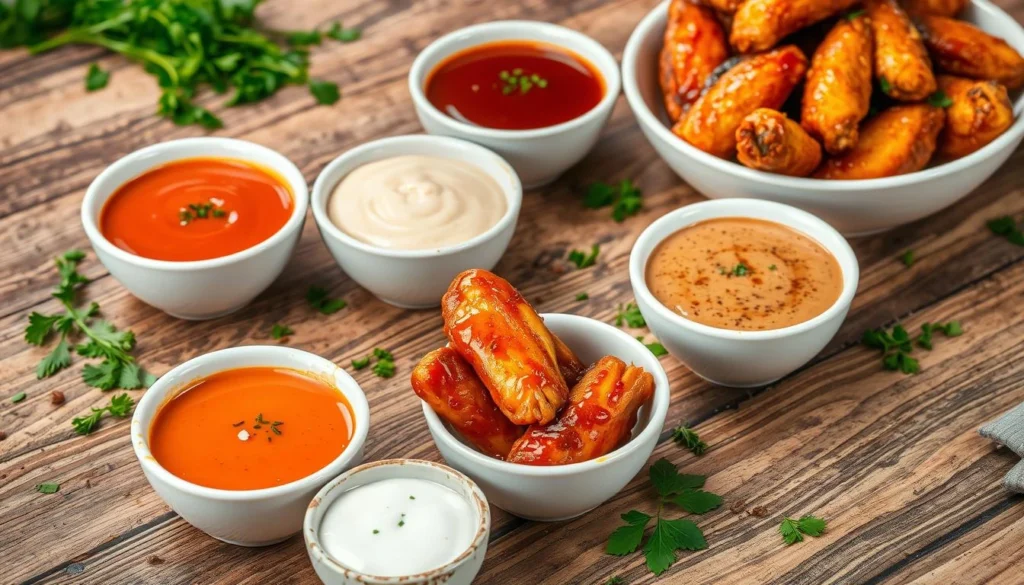
Different sauces offer unique flavors and nutritional effects. Let’s look at some popular sauces and what they bring to your wings.
Traditional Buffalo Sauce
Buffalo sauce is a favorite with little nutritional impact. It adds:
- 1-3 grams of carbs per serving
- Approximately 20 calories
- Low fat content
Teriyaki and Asian-Inspired Sauces
Asian-inspired sauces like teriyaki are sweeter but have more carbs. When counting carbs in chicken wings, remember:
- Teriyaki sauce can add 4-10 grams of carbs
- Sugar content is typically higher
- Protein contribution is minimal (around 1 gram)
BBQ Sauce Considerations
BBQ sauce is tasty but increases carbs in your wings. Key nutritional insights include:
- 4-10 grams of carbs per serving
- Higher sugar content (approximately 12 grams)
- Additional calories from added sugars
“Choose wisely – your sauce can make or break the nutritional value of your chicken wings.”
Pro tip: For lower-carb options, try dry rubs or homemade sauces with less sugar. This way, you can enjoy tasty wings while keeping carbs in check.
Nutritional Concerns and Considerations
It’s important to know the nutritional facts of chicken wings. They are tasty but have health impacts. This knowledge helps you make better food choices.
Chicken wings can have a lot of calories, especially if cooked in certain ways. A single serving has about 160 calories. Most of these calories come from fat, at 67.4%.
Sodium Levels in Sauces
Wing sauces can raise your sodium levels a lot. One serving of chicken wings has about 140.3mg of sodium. This is a big part of your daily sodium limit.
- Buffalo sauce tends to be high in sodium
- Teriyaki marinades can increase salt content
- BBQ sauces often contain hidden sodium
Caloric Content in Fried Wings
Fried chicken wings have a lot of calories. They have up to 40% more calories than baked or grilled wings. They also have a lot more fat.
| Preparation Method | Calories per Serving | Fat Content |
|---|---|---|
| Fried Wings | 160-200 calories | 12-15g |
| Baked Wings | 120-150 calories | 8-10g |
| Grilled Wings | 110-140 calories | 7-9g |
Pro tip: Choose grilling or baking to reduce chicken wings calories and maintain a healthier nutritional profile.
“Moderation and smart preparation are key to enjoying chicken wings without compromising your health goals.” – Nutrition Expert
Wrap-Up: Enjoying Chicken Wings Mindfully
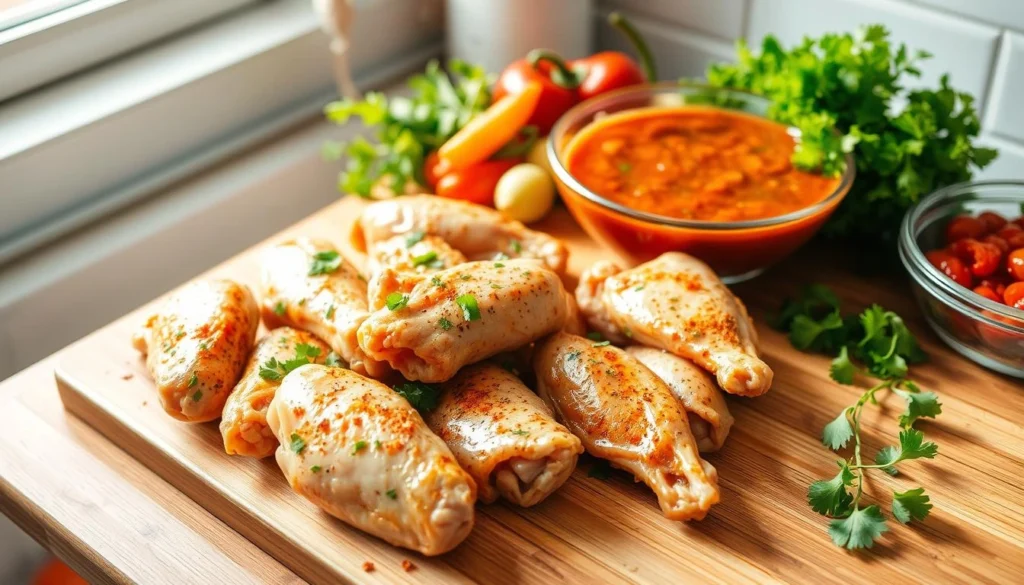
Enjoying healthy chicken wings doesn’t mean you have to give up on your diet goals. You can have this tasty protein and still eat well.
“Mindful eating is about experiencing food with intention and awareness.”
Studies show how important visual cues are in eating. A study found that seeing chicken wing bones on the plate made people eat less. This shows that being aware of how much you eat can help control your portions.
- Choose baking or air frying over deep-frying
- Opt for lean, skinless chicken wings when possible
- Use herbs and spices instead of heavy sauces
- Practice portion control
Cooking methods are key to making healthy chicken wings. Baking at 450 degrees F and checking for an internal temperature of 165 degrees F is safe and tasty. Air frying is another great low-fat option, needing only 18-20 minutes at 400 degrees F.
Pro tip: Store leftover wings in a covered container for up to 3 days in the refrigerator, maintaining their flavor and nutritional value.
| Cooking Method | Calories per Serving | Fat Content |
|---|---|---|
| Deep Fried | 298 | 23g |
| Baked | 200 | 12g |
| Air Fried | 220 | 15g |
Enjoying healthy chicken wings is all about balance, how you cook them, and eating mindfully. Your body will appreciate your healthy choices!
Additional Resources on Chicken Wing Nutrition
Exploring chicken wings nutrition? Look for trusted sources for detailed insights. The USDA FoodData Central gives you the exact protein, calorie, and nutrient content of chicken wings.
Health and fitness websites have expert recipes for healthier chicken wings. Tools like MyFitnessPal and nutrition apps help track your wing intake. They make it easy to stay on track with your diet.
Nutritionists suggest checking out scientific journals and dietitian websites for the latest on poultry nutrition. Local health experts can also offer personalized advice. They help you balance chicken wings with your diet and manage calories.
For the best info, rely on sources like the CDC, Academy of Nutrition and Dietetics, and scientific research. By choosing reliable sources, you’ll get a full picture of chicken wings nutrition.
FAQ
How many calories are in a typical chicken wing?
A small chicken wing (30g) has about 86.4 calories. A 100-gram serving of free-range chicken wings with skin can have 200-220 calories. This depends on how they are prepared and cooked.
Are chicken wings a good source of protein?
Absolutely! One chicken wing gives you 6-8 grams of protein. A 100-gram serving has 30-35 grams. This makes chicken wings great for building and keeping muscle.
What nutrients do chicken wings contain?
Chicken wings are full of important nutrients. They have vitamins A and B, calcium, iron, zinc, and selenium. They also have collagen, which is good for your gut and joints.
What is the healthiest way to prepare chicken wings?
The healthiest ways are baking, grilling, or air-frying. These methods use less fat and keep more nutrients. Avoid deep-frying and use less breading and healthier seasonings.
How do sauces affect the nutritional value of chicken wings?
Sauces can change the nutritional value a lot. Buffalo sauce adds 1-3g of carbs, teriyaki sauce 4-10g, and BBQ sauce 4-10g. Pick low-sugar sauces or dry rubs to keep carbs low.
Are chicken wings good for people on a low-carb diet?
Yes, chicken wings are almost carb-free. They’re great for low-carb and keto diets. Plain wings without breading or sugary sauces have almost no carbs.
What is a typical serving size for chicken wings?
A typical serving is 4-6 whole wings or 8-12 wing segments. When eating wings, watch your portion sizes. Pair them with veggies for a healthier meal.
Do free-range chicken wings have additional nutritional benefits?
Free-range chicken wings might have more omega-3 fatty acids and antioxidants than regular chickens. They can be better for your heart and immune system.
Can chicken wings be part of a healthy diet?
Yes, chicken wings can be part of a healthy diet if eaten mindfully. Choose healthier cooking methods, control portion sizes, and use minimal sauces. Balance them with other healthy foods.
Are there any nutritional concerns with eating chicken wings?
Be careful of high sodium in sauces and high calories in fried wings. A serving of fried wings can have up to 1,000 calories. Opt for baked or grilled wings and watch added sauces for a healthier diet.

